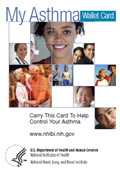Putting Guideline Priorities into Action
The science is clear and has been translated into evidence-based asthma guidelines. With proper care, most people can control their asthma. Yet the path to realizing the full potential of these guidelines to improve patient outcomes and to reduce asthma disparities has been far less visible.
In 2007, the National Asthma Education and Prevention Program (NAEPP), coordinated by the National Heart, Lung, and Blood Institute (NHLBI), released its third set of clinical practice recommendations for asthma. The Expert Panel Report 3—Guidelines for the Diagnosis and Management of Asthma (EPR-3) provides guidance for selecting treatment based on a patient’s individual needs and for maintaining treatment based on the level of asthma control. The recommendations were developed by a committee of 18 volunteer experts chosen for their scientific and clinical knowledge and experience.
The guidelines emphasize that while asthma can be controlled, the condition can change over time and differs among individuals and by age groups. Thus, it is important to monitor the patient’s level of asthma control so that treatment can be adjusted as needed.
Recognizing that more must be done to ensure that the type of care asthma patients should receive and the care that they do receive are one and the same, the NAEPP convened a diverse group of 17 national experts in asthma policy, clinical practice, research, public health, and education. It tasked the group with reviewing the EPR-3 recommendations to identify priority messages to improve implementation of the guidelines. The resulting Guidelines Implementation Panel (GIP) Report—Partners Putting Guidelines Into Action—which spurred the creation of the NACI—offers a roadmap for engaging a broad range of stakeholders in clear, achievable strategies for overcoming remaining barriers to using clinical guidelines in practice.
The NACI is focusing attention and resources on the six priority GIP messages that reinforce EPR-3 clinical practice recommendations vital for asthma control and high-quality patient-centered care. If practiced widely and routinely, these messages have the potential to change lives.
The following links provide an overview of each GIP message with more detailed information available in the EPR-3 clinical practice guidelines.
- Use inhaled corticosteroids to control asthma.
- Use written asthma action plans to guide patient self-management.
- Assess asthma severity at the initial visit to determine initial treatment.
- Assess and monitor asthma control and adjust treatment if needed.
- Schedule follow-up visits at periodic intervals.
- Control environmental exposures that worsen the patient’s asthma.
We invite you to become part of the NACI. Join the NACI and its partners in using evidence-based messages and best practices to enhance asthma care and patient self-management.

















 Twitter
Twitter
 Facebook
Facebook YouTube
YouTube